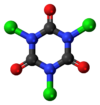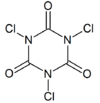Difference between revisions of "Trichloroisocyanuric acid"
| (6 intermediate revisions by 2 users not shown) | |||
| Line 23: | Line 23: | ||
| ImageAlt3 = | | ImageAlt3 = | ||
| ImageName3 = | | ImageName3 = | ||
| − | | ImageFileL1 = | + | | ImageFileL1 = TCCA-0.png |
| − | | ImageSizeL1 = | + | | ImageSizeL1 = 100 |
| ImageAltL1 = | | ImageAltL1 = | ||
| ImageNameL1 = | | ImageNameL1 = | ||
| − | | ImageFileR1 = | + | | ImageFileR1 = TCCA.png |
| − | | ImageSizeR1 = | + | | ImageSizeR1 = 100 |
| ImageAltR1 = | | ImageAltR1 = | ||
| ImageNameR1 = | | ImageNameR1 = | ||
| Line 58: | Line 58: | ||
| MolarMass = 232.40 g/mol | | MolarMass = 232.40 g/mol | ||
| MeltingPt = | | MeltingPt = | ||
| − | | MeltingPtC = | + | | MeltingPtC = 246.7 |
| MeltingPt_ref = | | MeltingPt_ref = | ||
| − | | MeltingPt_notes = | + | | MeltingPt_notes = (decomposes) |
| − | | pKa = | + | | Odor = Chlorine-like |
| + | | pKa = 4.4 | ||
| pKb = | | pKb = | ||
| − | | Solubility = 1. | + | | Solubility = 1.27 g/100 ml (25 °C) |
| − | | SolubleOther = Soluble in [[acetone]], [[acetonitrile]], chlorocarbons | + | | SolubleOther = Reacts with [[ammonia]]<br>Soluble in [[acetone]], [[acetonitrile]], chlorocarbons |
| − | | | + | | Solubility1 = 30 g/100 g (30 °C) |
| − | | VaporPressure = | + | | Solvent1 = acetone |
| + | | VaporPressure = 1.6·10<sup>-8</sup> mmHg (25 °C) | ||
}} | }} | ||
| Section3 = {{Chembox Structure | | Section3 = {{Chembox Structure | ||
| Line 88: | Line 90: | ||
| Section6 = {{Chembox Hazards | | Section6 = {{Chembox Hazards | ||
| AutoignitionPt = Non-flammable | | AutoignitionPt = Non-flammable | ||
| − | | ExploLimits = | + | | ExploLimits = Non-explosive |
| ExternalMSDS = [https://www.docdroid.net/Na8mDxI/trichloroisocyanuric-acid-sa.pdf.html Sigma-Aldrich] | | ExternalMSDS = [https://www.docdroid.net/Na8mDxI/trichloroisocyanuric-acid-sa.pdf.html Sigma-Aldrich] | ||
| FlashPt = Non-flammable | | FlashPt = Non-flammable | ||
| Line 104: | Line 106: | ||
| OtherFunction = | | OtherFunction = | ||
| OtherFunction_label = | | OtherFunction_label = | ||
| − | | OtherCompounds = | + | | OtherCompounds = [[Cyanuric acid]] |
}} | }} | ||
}} | }} | ||
| − | |||
| − | |||
'''Trichloroisocyanuric acid''' (abbreviated '''TCCA''') is a useful chlorinating agent and is commonly used to produce [[chlorine]] gas. | '''Trichloroisocyanuric acid''' (abbreviated '''TCCA''') is a useful chlorinating agent and is commonly used to produce [[chlorine]] gas. | ||
==Properties== | ==Properties== | ||
===Chemical=== | ===Chemical=== | ||
| − | TCCA is basically insoluble in water. On | + | TCCA is basically insoluble in water. On reaction with [[hydrochloric acid]], it loses chlorine to become [[cyanuric acid]]. |
| + | |||
| + | : C<sub>3</sub>Cl<sub>3</sub>N<sub>3</sub>O<sub>3</sub> + 3 HCl → C<sub>3</sub>H<sub>3</sub>N<sub>3</sub>O<sub>3</sub> + 3 Cl<sub>2</sub> | ||
Reaction with [[ammonia]] produces [[chloroamine]]s. | Reaction with [[ammonia]] produces [[chloroamine]]s. | ||
| Line 122: | Line 124: | ||
1) For a given amount of TCCA, it produces a lot of chlorine, more so than other methods. | 1) For a given amount of TCCA, it produces a lot of chlorine, more so than other methods. | ||
| − | 2) The reaction is slow and steady, not releasing all its chlorine at once in a violent and foaming reaction as is often the case with [[calcium hypochlorite | + | 2) The reaction is slow and steady, not releasing all its chlorine at once in a violent and foaming reaction as is often the case with [[calcium hypochlorite]]. A more violent reaction is also more likely to bring over water vapor and HCl fumes, as well as creating an inhalation hazard, which is generally unfavorable. |
3) The solid comes in easy to handle blocks that can be broken down to suitable sized chunks or a powder. | 3) The solid comes in easy to handle blocks that can be broken down to suitable sized chunks or a powder. | ||
| Line 134: | Line 136: | ||
==Availability== | ==Availability== | ||
| − | It is available in a quite pure form in many countries as a slow chlorinating agents for swimming pools. It can be purchased online too, where it is usually quite cheap. | + | It is available in a quite pure form in many countries as a slow chlorinating agents for swimming pools, though it's more often encountered as its sodium salt. It can be purchased online too, where it is usually quite cheap. |
==Preparation== | ==Preparation== | ||
| Line 141: | Line 143: | ||
==Projects== | ==Projects== | ||
*Producing chlorine gas | *Producing chlorine gas | ||
| − | *Copper cyanurate | + | *Make cyanuric acid |
| + | *Copper cyanurate [[File:Sodium_copper_dichloroisocyanurate.jpg|200px|thumb|Complex between copper and Na-DCCA]] | ||
*Making singlet oxygen | *Making singlet oxygen | ||
| Line 149: | Line 152: | ||
===Storage=== | ===Storage=== | ||
| − | TCCA is best stores in closed containers, in dark, well ventilated areas. Keep it away from any flammable materials, bases, acids. Since it gives off chlorine over time, keep it in a separate place from other reagent. | + | TCCA is best stores in closed plastic containers, in dark, well ventilated areas. Keep it away from any flammable materials, bases, acids. Since it gives off chlorine over time, keep it in a separate place from other reagent. |
===Disposal=== | ===Disposal=== | ||
| − | Can be neutralized with sodium thiosulfate | + | Can be neutralized with an aqueous solution of [[sodium thiosulfate]]/sulfite/bisulfite/metabisulfite. |
==References== | ==References== | ||
| Line 158: | Line 161: | ||
Tdep. | Tdep. | ||
===Relevant Sciencemadness threads=== | ===Relevant Sciencemadness threads=== | ||
| + | *[http://www.sciencemadness.org/talk/viewthread.php?tid=64964 TCCA Synthesis?] | ||
| + | *[http://www.sciencemadness.org/talk/viewthread.php?tid=25673 What to do with TCCA (Trichloroisocyanuricacid)] | ||
| + | *[http://www.sciencemadness.org/talk/viewthread.php?tid=5686 TCCA, Na-DCCA and cyanuric acid] | ||
| + | *[http://www.sciencemadness.org/talk/viewthread.php?tid=24088 TCCA bleach] | ||
[[Category:Chemical compounds]] | [[Category:Chemical compounds]] | ||
Latest revision as of 09:53, 13 July 2022
|
| |||
| Names | |||
|---|---|---|---|
| IUPAC name
1,3,5-Trichloro-1,3,5-triazinane-2,4,6-trione
| |||
| Other names
1,3,5-Trichloro-1,3,5-triazine-2,4,6(1H,3H,5H)-trione
Chloreal Isocyanuric chloride Symclosene TCCA TCICA Trichlor Trichloro-s-triazinetrione | |||
| Properties | |||
| C3Cl3N3O3 | |||
| Molar mass | 232.40 g/mol | ||
| Appearance | Colorless solid | ||
| Odor | Chlorine-like | ||
| Density | 2.19 g/cm3 | ||
| Melting point | 246.7 °C (476.1 °F; 519.8 K) (decomposes) | ||
| Boiling point | Decomposes | ||
| 1.27 g/100 ml (25 °C) | |||
| Solubility | Reacts with ammonia Soluble in acetone, acetonitrile, chlorocarbons | ||
| Solubility in acetone | 30 g/100 g (30 °C) | ||
| Vapor pressure | 1.6·10-8 mmHg (25 °C) | ||
| Acidity (pKa) | 4.4 | ||
| Hazards | |||
| Safety data sheet | Sigma-Aldrich | ||
| Flash point | Non-flammable | ||
| Related compounds | |||
| Related compounds
|
Cyanuric acid | ||
| Except where otherwise noted, data are given for materials in their standard state (at 25 °C [77 °F], 100 kPa). | |||
| Infobox references | |||
Trichloroisocyanuric acid (abbreviated TCCA) is a useful chlorinating agent and is commonly used to produce chlorine gas.
Contents
Properties
Chemical
TCCA is basically insoluble in water. On reaction with hydrochloric acid, it loses chlorine to become cyanuric acid.
- C3Cl3N3O3 + 3 HCl → C3H3N3O3 + 3 Cl2
Reaction with ammonia produces chloroamines.
Producing chlorine
The reaction between it and hydrochloric acid is favorable for a few reasons.
1) For a given amount of TCCA, it produces a lot of chlorine, more so than other methods.
2) The reaction is slow and steady, not releasing all its chlorine at once in a violent and foaming reaction as is often the case with calcium hypochlorite. A more violent reaction is also more likely to bring over water vapor and HCl fumes, as well as creating an inhalation hazard, which is generally unfavorable.
3) The solid comes in easy to handle blocks that can be broken down to suitable sized chunks or a powder.
4) All the reactants and products are easy to clean from glassware, unlike manganese dioxide.
5) TCCA is usually cheap, especially when bought in bulk, so the cost per amount of chlorine produced is very low.
Physical
A white solid that has an odor similar to chlorine itself, it is often sold in big white circular 'tablets'.
Availability
It is available in a quite pure form in many countries as a slow chlorinating agents for swimming pools, though it's more often encountered as its sodium salt. It can be purchased online too, where it is usually quite cheap.
Preparation
TCCA can not be made easily, nor is it often desired to be due to its wide availability and alternatives if it can not be found. It can be made by clorinating cyanuric acid.
Projects
- Producing chlorine gas
- Make cyanuric acid
- Copper cyanurate
- Making singlet oxygen
Handling
Safety
Gloves should be worn when dealing with TCCA and care should be taken to avoid breathing in any dust. TCCA spontaneously produces large volumes of toxic chlorine in many reactions, so safety plans that dramatically reduce the chlorine's danger to you should in place when dealing with this chemical.
Storage
TCCA is best stores in closed plastic containers, in dark, well ventilated areas. Keep it away from any flammable materials, bases, acids. Since it gives off chlorine over time, keep it in a separate place from other reagent.
Disposal
Can be neutralized with an aqueous solution of sodium thiosulfate/sulfite/bisulfite/metabisulfite.
References
Tdep.


